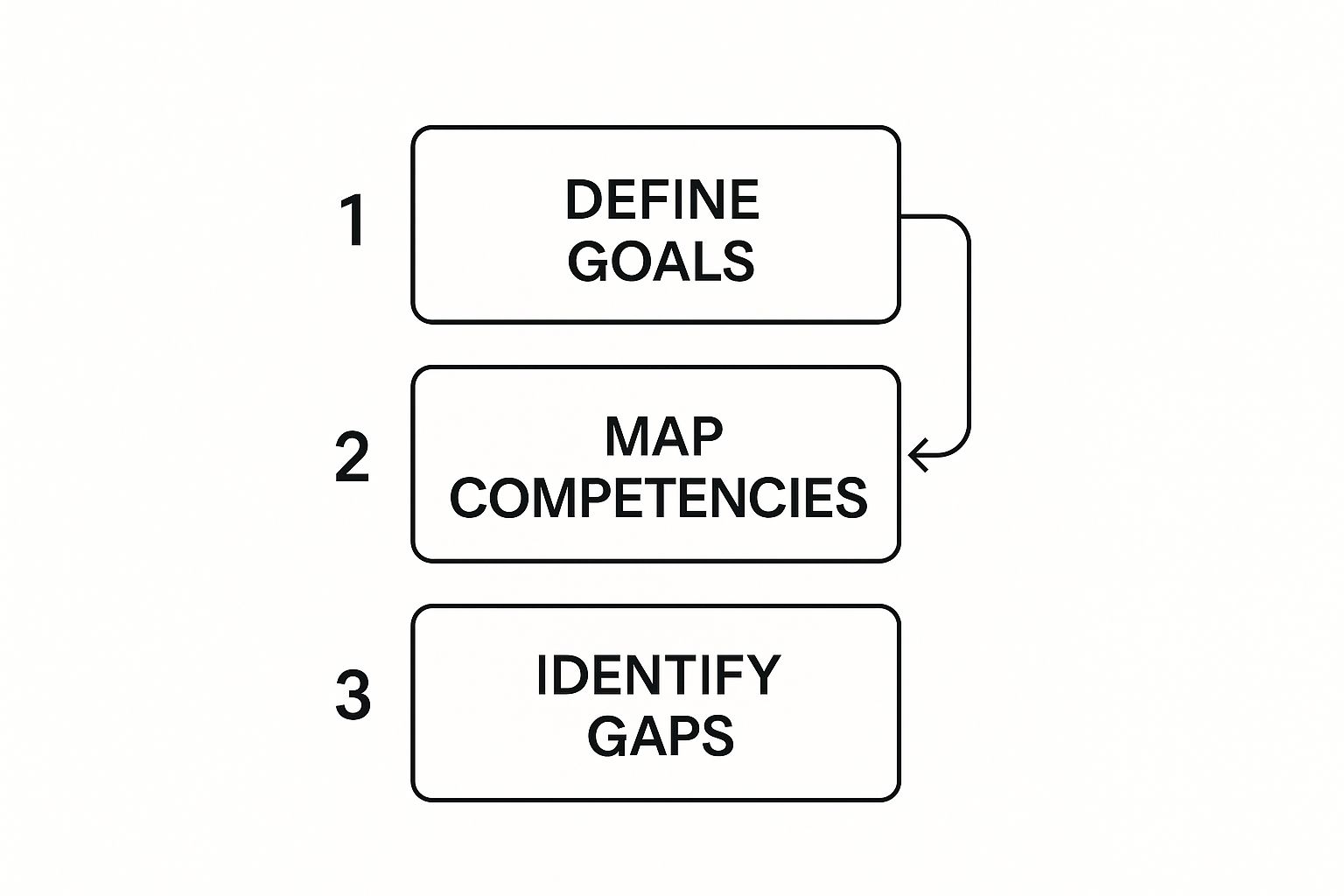The Strategic Foundation of Training Needs Analysis

A Training Needs Analysis (TNA) is the cornerstone of any successful learning and development program. It's a systematic process that transforms training from a reactive cost into a proactive investment in your organization's growth. This strategic approach ensures training budgets are used effectively, addressing real performance gaps, not just perceived ones.
Think of a doctor diagnosing a patient: they wouldn't prescribe medicine without understanding the illness. Effective training begins with understanding your organization's specific needs. This targeted approach maximizes the impact of training on employee performance and business outcomes, while saving valuable resources.
Why TNA Is Crucial for Organizational Success
A training needs analysis bridges the gap between current employee capabilities and desired organizational outcomes. It identifies discrepancies between actual performance and the performance needed to achieve strategic objectives. This is crucial in today's rapidly evolving job market.
For example, 52% of workers admit they need new skills to advance their careers. Furthermore, 46% of employees acknowledge they lack necessary skills. These statistics highlight the urgent need for robust training strategies. Investing in employee development, like Amazon's $1.2 billion upskilling initiative, prepares the workforce for future challenges. Find more statistics at: Employee Training Statistics. This foundational understanding paves the way for impactful training programs.
Aligning Training with Business Goals
Training should always be aligned with measurable business outcomes. Effective TNA frameworks connect development efforts directly to Key Performance Indicators (KPIs) and overall strategic objectives.
For instance, if a company wants to improve customer satisfaction, a TNA might reveal a need for training in customer service or product knowledge. Addressing this gap directly contributes to the desired outcome. This targeted approach demonstrates the tangible value of learning and development investments to leadership. More insights can be found here: How to Master HR Compliance Training. This alignment integrates training into the pursuit of organizational success.
Building a Culture of Continuous Improvement
A robust TNA process cultivates a culture of continuous improvement. Regularly assessing training needs and evaluating program effectiveness allows businesses to adapt to evolving challenges and opportunities.
This iterative approach ensures training stays relevant and impactful, driving ongoing growth and development. These insights enable businesses to adapt to changing demands and maintain a competitive edge.
Breaking Down the Analysis Process That Actually Works
Forget the theoretical, let's get practical! This section walks you through a proven training needs analysis process used by seasoned L&D professionals. Learn how to effectively engage stakeholders, avoid common data collection pitfalls, and transform your findings into actionable recommendations. This process provides a clear structure for each stage, empowering you to navigate organizational complexities and ensure your insights lead to meaningful change.
Defining the Scope and Purpose
Every successful journey begins with a clear destination. Start by defining the scope and purpose of your training needs analysis. What specific problem are you trying to solve? What are your objectives? This clarity ensures everyone is aligned from the start. For instance, if customer satisfaction is declining, your purpose might be to identify training needs related to customer service skills. A well-defined scope focuses your efforts, preventing the analysis from becoming too broad. This initial step sets the foundation for a successful and impactful analysis.
Mapping Key Competencies and Identifying Gaps
Once you've defined your scope, the next vital step is mapping the key competencies required for optimal performance. This means outlining the essential skills, knowledge, and behaviors needed for specific roles or tasks. By assessing current employee capabilities against these benchmarks, you can pinpoint any existing gaps. This targeted approach ensures resources are allocated efficiently, maximizing the impact of your training interventions.

This infographic illustrates the process: defining clear goals provides the context for mapping necessary competencies, leading to the identification of specific skill gaps. This streamlined approach directly ties training to organizational objectives, addressing the most critical needs.
Prioritizing and Validating Findings
Not all training needs are equal. Prioritize identified gaps based on factors like business impact, feasibility, and urgency. Focus on addressing the most critical needs first to maximize your return on investment. This strategic prioritization ensures training resources are allocated where they'll have the greatest positive impact. You might be interested in: How to master human resource training.
Next, validate your findings with key stakeholders—managers, employees, and subject matter experts. This collaborative approach fosters buy-in and refines your recommendations, aligning your analysis with organizational realities and priorities. This sets the stage for developing focused and effective training solutions.
To help visualize the training needs analysis process, we've created a table outlining the key stages, activities, and expected outcomes:
Introduction to Table: The following table provides a detailed breakdown of the training needs analysis process, outlining the key activities and outputs at each stage to help guide you through the process.
| Process Stage | Key Activities | Expected Outputs | Time Frame |
|---|---|---|---|
| Defining the Scope and Purpose | Identify the problem, set objectives, define boundaries | Clear scope and purpose statement, stakeholder alignment | 1 week |
| Mapping Key Competencies | Analyze job roles, identify required skills & knowledge | Competency map, skills gap analysis | 2 weeks |
| Prioritizing and Validating | Rank needs by business impact, feasibility, urgency | Prioritized list of training needs, stakeholder buy-in | 1 week |
| Developing Actionable Recommendations | Propose training programs, resources, strategies | Actionable training plan, implementation roadmap | 2 weeks |
Conclusion from Table: This table provides a practical framework for conducting a thorough training needs analysis. By following these stages, you can ensure your training initiatives are targeted, impactful, and aligned with your organization's overall goals.
Developing Actionable Recommendations
Finally, translate your analysis into clear, actionable recommendations. This involves proposing specific training programs, learning resources, and implementation strategies. Ensure your recommendations align with the prioritized needs and effectively address the identified skill gaps. This practical approach ensures your training needs analysis leads to tangible improvements in employee performance and organizational outcomes, driving real change within the organization.
Data Collection Methods That Reveal the Truth

Effective training needs analysis hinges on gathering accurate and insightful data. This involves using a combination of qualitative and quantitative methods to create a comprehensive understanding of your organization's learning and development opportunities. This balanced approach helps you capture both the "what" and the "why," which are key to developing truly effective training programs.
Qualitative Data Collection: Uncovering the "Why"
Qualitative methods offer rich, detailed insights into the reasons behind performance gaps. These methods often involve direct interaction with your employees, allowing you to explore their unique perspectives and experiences. This deep dive goes beyond surface-level observations and provides a more complete view of the challenges and opportunities within your organization.
-
Interviews: One-on-one conversations facilitate in-depth exploration of individual experiences, uncovering hidden challenges and opportunities often missed by broader data collection methods. These personalized interactions can reveal valuable insights that inform targeted training solutions.
-
Focus Groups: Group discussions foster diverse viewpoints and encourage brainstorming, surfacing shared challenges and potential solutions. This collaborative approach promotes open dialogue and can spark innovative ideas for addressing training needs.
-
Observations: Directly observing employees in their roles provides real-time insights into workflows and potential bottlenecks. This firsthand observation can reveal hidden inefficiencies that other data collection methods might overlook.
Quantitative Data Collection: Measuring the "What"
Quantitative methods offer measurable data that can be statistically analyzed, helping you quantify the scope of training needs and track the effectiveness of your training programs. This data-driven approach allows for objective assessment and measurement of progress towards your goals.
-
Surveys: Standardized questionnaires collect data from a large group of employees, providing a broad overview of training needs across your organization. This broad perspective allows you to identify common trends and challenges. Consider utilizing survey tools like SurveyMonkey or Typeform to streamline this process.
-
Performance Data: Analyzing existing performance metrics, such as sales figures or customer satisfaction scores, highlights areas where training can make the biggest impact. This data-driven approach ensures training is focused where it matters most, maximizing its potential for positive change.
-
Tests and Assessments: Skill assessments measure current skill levels and identify specific areas where employees require development. This targeted approach facilitates the creation of personalized training plans that address individual needs and unlock employee potential.
To further explore the various methods available, the table below provides a detailed comparison:
Introduction to Table: The following table offers a comparative analysis of the data collection methods discussed, outlining their strengths, limitations, and ideal applications. This will help you determine the most effective approach for your specific training needs analysis.
| Method | Strengths | Limitations | Best For | Resource Requirements |
|---|---|---|---|---|
| Interviews | In-depth insights, personalized information | Time-consuming, potential for interviewer bias | Exploring complex issues, understanding individual perspectives | Trained interviewer, time for interviews and analysis |
| Focus Groups | Diverse perspectives, collaborative brainstorming | Groupthink, potential for dominant personalities to overshadow others | Gathering broad feedback, identifying common themes | Skilled facilitator, time for sessions and analysis |
| Observations | Real-time insights, objective data | Observer effect (employees may change behavior when observed), limited context | Identifying workflow inefficiencies, understanding actual job tasks | Trained observer, time for observation and analysis |
| Surveys | Broad reach, efficient data collection | Limited depth of information, potential for low response rates | Assessing widespread needs, identifying general trends | Survey design expertise, platform for distribution and analysis |
| Performance Data | Objective metrics, quantifiable results | May not reveal underlying causes of performance gaps | Measuring training impact, identifying areas for improvement | Access to performance data, analytical skills |
| Tests & Assessments | Targeted skill measurement, identifies specific needs | Can be stressful for employees, may not capture all relevant skills | Assessing current skill levels, creating personalized training plans | Valid and reliable assessments, platform for administration and analysis |
Conclusion from Table: As highlighted in the table, each data collection method has its own unique advantages and disadvantages. Choosing the right combination of methods is essential to gaining a comprehensive understanding of your organization’s training needs.
Triangulating Data for Accurate Insights
Combining qualitative and quantitative data, known as data triangulation, strengthens the validity of your findings. Using different data sources provides a more robust and reliable understanding, much like using multiple navigation tools to pinpoint your location. This approach minimizes the risk of bias or misinterpretation.
For instance, if survey data reveals low customer satisfaction, following up with interviews can uncover the root causes. Learn more in our article about How to Master HR Data Analytics. This multi-faceted approach ensures your training recommendations are well-supported and aligned with organizational realities. By carefully selecting and combining methods, you can gain the necessary insights to develop truly impactful training programs.
Connecting Training Needs to Business Outcomes
Training should never be conducted just for the sake of it. It's essential to connect identified skill gaps to the business outcomes that matter most to your executives. This involves learning to speak the language of various stakeholders and showcasing the financial impact of addressing performance gaps. By doing so, you transform training from a perceived cost center into a valuable strategic investment.
Speaking the Language of Stakeholders
Every stakeholder group has unique priorities. Operations managers, for example, are often focused on efficiency and productivity. Executives, on the other hand, tend to prioritize market position and profitability.
This means tailoring your communication to resonate with each group. When presenting to operations managers, highlight how training can reduce errors and improve workflow. When speaking with executives, emphasize how training can drive innovation and increase market share.
Gathering performance data is essential. Utilizing tools that streamline HR and performance management can offer valuable insights into areas where training can make the biggest difference. This data-driven approach demonstrates the true value of your training initiatives.
Demonstrating ROI and Building a Business Case
Securing budget approval requires a compelling business case. This means demonstrating the Return on Investment (ROI) of your training programs. One effective strategy is calculating the cost of not training.
Consider the costs associated with low employee engagement, high turnover, or poor customer service. By comparing these costs to the cost of training, you can build a strong financial argument for your proposed programs. Highlighting how training contributes to long-term capability building further strengthens your case, positioning training as a crucial investment in the organization's future.
A training needs analysis isn't just about identifying gaps. It's about aligning workforce capabilities with strategic business objectives. This ensures that training initiatives are relevant, efficient, and contribute to the organization's overall vision. A thorough analysis helps avoid unnecessary training costs and boosts employee engagement. Employees appreciate organizations that invest in their professional development. A well-executed training needs analysis prepares businesses for future challenges and innovations, especially as industries face rapid technological advancements and shifting consumer demands. Learn more here: Training Needs Analysis: A Strategic Guide.
Establishing Meaningful Metrics
Defining clear metrics is the final step. These metrics should track both learning outcomes (such as knowledge gained and skills acquired) and business impact (like increased sales or improved customer satisfaction).
This data-driven approach demonstrates program effectiveness and justifies continued investment. This ongoing evaluation also ensures continuous improvement and keeps training aligned with evolving business needs. Resources like How to Master Strategic Workforce Planning can provide further guidance. By connecting training to tangible results, you demonstrate its strategic value and secure its role in organizational success.
Harnessing Technology to Transform Your Analysis

Spreadsheets and surveys once dominated training needs analysis. Today, insightful organizations are embracing technology to reshape this crucial process. This evolution leads to more effective data gathering, a richer understanding of skill deficiencies, and the power to anticipate future capability needs. This proactive strategy ensures training programs are not just relevant, but also aligned with the ever-changing demands of the organization.
Leveraging AI and Analytics for Deeper Insights
Artificial intelligence (AI) and analytics are at the heart of modern training needs analysis. AI can process immense amounts of data from various sources, such as performance systems, learning platforms, and even business metrics. It unveils patterns and connections that would be nearly impossible for humans to find manually.
This empowers L&D professionals to identify hidden skill gaps and target training where it's most needed. For instance, AI can analyze employee performance data to pinpoint specific skills or knowledge areas requiring improvement. This focused strategy maximizes the impact of training programs. Looking ahead, AI can also predict future skill requirements based on industry developments and organizational objectives, enabling proactive training program development.
Integrating Data for a Holistic View
Integrating data from multiple sources paints a comprehensive picture of your organization's capabilities. By combining data from performance management systems, learning management systems (LMS), and business intelligence platforms, you gain a complete view of employee skills and performance.
This holistic perspective links training needs directly to business results, creating a continuous feedback loop. You can monitor training program effectiveness and adjust as needed, ensuring your programs remain relevant and impactful. The fusion of technology and personalized learning is transforming employee training.
In 2025, the trend towards digital learning and AI-driven training is projected to accelerate, with 93% of employees favoring straightforward training programs. Digital platforms also optimize ROI by ensuring engaging and impactful training. As industries evolve, integrating technology into training needs analysis will be essential for maintaining a competitive edge. For a deeper dive into these trends, explore these illuminating statistics: Employee Training Statistics.
Practical Applications for Different Maturity Levels
Organizations vary in their level of digital maturity. Regardless of your current technological capabilities, there are practical ways to utilize technology for improved training needs analysis. Even organizations with limited resources can gain valuable insights using simple online survey tools or basic data analysis software.
More technologically advanced organizations can explore AI-powered platforms that offer predictive analytics and personalized learning recommendations. Selecting the right technology for your organization's specific needs and maturity level ensures maximum return on investment. Remember, technology should complement human insight, not replace it. The ultimate goal is to use technology to enhance your analysis and ensure your training programs deliver tangible business value.
Transforming Analysis Insights Into Learning That Delivers
The gap between identifying training needs and delivering effective training can be a real stumbling block for organizations. This section offers practical frameworks for turning your analysis findings into powerful learning experiences that truly change behavior and boost performance. This vital step ensures your training investments yield tangible results.
Selecting the Right Learning Approaches
Successful L&D teams thoughtfully choose the best learning approaches based on several factors. These include the specific gaps identified, the characteristics of the target audience, and any organizational limitations. For example, if your analysis reveals a need for better communication skills, a workshop emphasizing role-playing and feedback might be more effective than an online module. Consider the learning styles and preferences of your audience. Some learners excel in collaborative settings, while others prefer self-directed learning. Balancing these needs is key for optimal engagement and knowledge retention.
Developing Targeted Learning Objectives
Learning objectives should directly address the performance gaps discovered during your training needs analysis. These objectives offer a clear roadmap for both learners and trainers, ensuring everyone is focused on the desired outcomes. For example, if a gap exists in customer service skills, a learning objective could be "Increase customer satisfaction scores by 10% within three months of completing the training." This specific and measurable objective sets a clear target for improvement.
Designing Measurement Approaches That Demonstrate Impact
Measuring the impact of your training is crucial for proving its value. This means designing evaluation methods that assess both the learning outcomes and the effect on business results. This data-driven strategy justifies continued investment in training and showcases its contribution to organizational success. Learn more in our article about how to measure training effectiveness. This vital step demonstrates the return on investment of your L&D initiatives.
Creating Implementation Roadmaps
A successful implementation roadmap balances immediate wins with sustained skill development. Prioritize addressing the most pressing needs first to demonstrate quick results and build momentum. However, don't overlook long-term development goals. Consider using marketing workflow automation to streamline training processes and boost efficiency. Incorporate continuous learning opportunities to reinforce new skills and encourage ongoing professional development. This balanced approach ensures both short-term and long-term gains.
Communicating Your Plan to Stakeholders
Effectively communicating your training plan to stakeholders is essential for securing support and resources. Craft clear and concise presentations that highlight the link between the training initiatives and business objectives. Use data and visuals to show the potential impact of the training programs, emphasizing the return on investment. Sharing success stories of similar programs can further bolster your argument and inspire confidence in your approach.
Ready to enhance your HR skills and contribute to organizational success? Explore the diverse range of programs offered by the Global Human Resource Institute. From foundational certifications like HRQP to advanced credentials like HRAP and expert-level designations like HRCE, we offer the knowledge and resources you need to thrive in today's dynamic HR field. Join our flourishing community of HR professionals and unlock your full potential. Visit us at Global Human Resource Institute to learn more and begin your journey toward HR excellence.




0 Comments